
HMAS Swordsman (H11) was an Admiralty S-class destroyer of the Royal Australian Navy (RAN). Built for the Royal Navy during World War I, the ship was not completed until 1919, and was transferred to the RAN at the start of 1920. The destroyer's career was uneventful, with most of it spent moored in Sydney. Swordsman was decommissioned in 1929, and scuttled off Sydney in 1939.

The Arethusa-class cruisers were a class of eight oil-fired light cruisers of the Royal Navy all ordered in September 1912, primarily for service in the North Sea. They had three funnels with the middle one somewhat larger in diameter than the others. All served in the First World War. They were found to be very cramped internally.

The V and W class was an amalgam of six similar classes of destroyer built for the Royal Navy under the 9th, 10th, 13th and 14th of fourteen War Emergency Programmes during the First World War and generally treated as one class. For their time they were among the most powerful and advanced ships of their type in the world, and set the trend for future British designs.

The Freccia-class destroyer was a class of destroyers built for the Regia Marina in the 1930s. Four modified ships were built and delivered in 1933 for Greece.
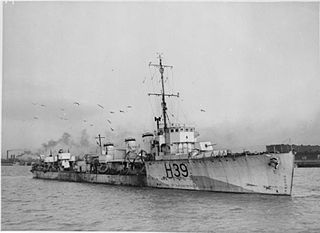
The first R class were a class of 62 destroyers built between 1916 and 1917 for the Royal Navy. They were an improvement, specifically in the area of fuel economy, of the earlier Admiralty M-class destroyers. The most important difference was that the Admiralty R class had two shafts and geared turbines, compared with the three shafts and direct turbines of the Admiralty M class, but in appearance the R class could be distinguished from its predecessors by having the after 4-inch gun mounted in a bandstand. The Admiralty ordered the first two of this class of ships in May 1915. Another seventeen were ordered in July 1915, a further eight in December 1915, and a final twenty-three in March 1916.
HMS Nomad was an Admiralty M-class destroyer built for the Royal Navy during the First World War. She was sunk during the Battle of Jutland in 1916.

HMS Vansittart was an Admiralty modified W-class destroyer built for the Royal Navy. She was ordered in January 1918 from William Beardmore & Company with the 13th Order for Destroyers of the Emergency War Program of 1918–19. She was the second Royal Navy ship to carry the name which was first used in 1821 for a hired packet.

HMS Racehorse was a three-funnel, 30-knot torpedo boat destroyer built by Hawthorn Leslie for the Royal Navy. Ordered by the Royal Navy under the 1898–1899 Naval Estimates, she was the eighth ship to carry this name since it was introduced in 1757. She served in World War I and was sold for breaking in 1920.
HMS Lassoo was a Laforey-class destroyer built for the Royal Navy during the 1910s.
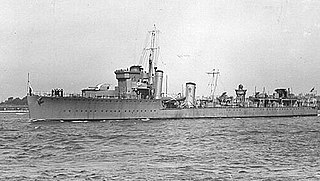
HMS Whitley (L23), ex-Whitby, was a W-class destroyer of the British Royal Navy that saw service in the British campaign in the Baltic Sea against Bolshevik forces during the Russian Civil War and in the early months of World War II.

The first HMS Walrus (D24) was a W-class destroyer of the British Royal Navy that saw service in the final months of World War I.
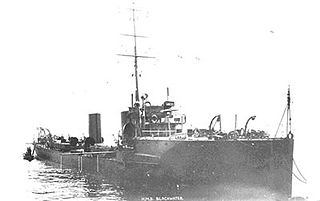
HMS Blackwater was a Laird-type River-class destroyer ordered by the Royal Navy under the 1902–1903 Naval Estimates. Named after the River Blackwater in southern England near London she was the first ship to carry this name in the Royal Navy.
HMS Foyle was a Laird-type River-class destroyer ordered by the Royal Navy under the 1902–1903 Naval Estimates. Named after the River Foyle in Ireland, she was the first ship to carry this name in the Royal Navy.
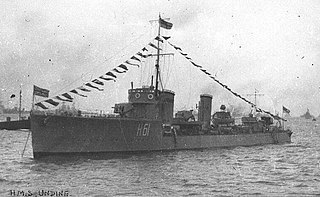
HMS Ulysses was a Royal Navy modified R-class destroyer constructed and then operational in the First World War.
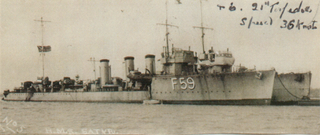
HMS Satyr was an R-class destroyer which served with the Royal Navy during the First World War. Launched on 27 December 1916, Satyr joined the Harwich Force under the command of Commander Hubert de Burgh. In 1917, the destroyer formed part of a force protecting the monitors Erebus and Terror in their bombardment of Ostend. As part of this action, Satyr, along with sister ships Taurus, Sharpshooter and Torrent, sank the German destroyer S20. After the war, the ship served with the Torpedo School at the Devonport. In 1923, the Navy decided to retire many of the older destroyers in preparation for the introduction of newer and larger vessels and Satyr was sold to be broken up on 16 December 1926.

HMS Tactician was an S-class destroyer, which served with the Royal Navy. Launched on 7 August 1918, the vessel entered service at the closing of the First World War. The ship joined the Fourteenth Destroyer Flotilla of the Grand Fleet but was placed in Reserve at Nore in 1919. Tactician deteriorated over the following years and was sold to be broken up on 5 February 1931 following the signing of the London Naval Treaty that limited the amount of destroyer tonnage that the Navy could retain.

HMS Tara was an S-class destroyer, which served with the Royal Navy. Launched on 7 August 1918, the vessel entered service at the closing of the First World War. The ship joined the Fourteenth Destroyer Flotilla of the Grand Fleet but was placed in Reserve at Nore in 1919. Tara deteriorated over the following years and was sold to be broken up on 17 December 1931 after the signing of the London Naval Treaty that limited the amount of destroyer tonnage the Navy could retain.

HMS Pellew was a Admiralty M-class destroyer which served with the Royal Navy during the First World War. The M class were an improvement on the preceding L class, capable of higher speed. Launched on 18 April 1916, the vessel served with the Grand Fleet escorting convoys. The vessel was part of an unsuccessful attempt by the navy to trap the German submarines that had taken such a heavy toll on merchant shipping in December 1917. The action involved an eight-ship convoy consisting of four merchant vessels escorted by two armed trawlers and the sister ships Pellew and Partridge. Instead of submarines, four German destroyers attacked, sinking all but one member of the convoy and disappearing before the light cruisers which were to be the spring in the trap could arrive. Pellew, the sole survivor, took refuge in a Norwegian fjord. After the armistice that ended the war, the destroyer was placed in reserve and subsequently sold to be broken up on 9 May 1921.
Three vessels and two shore establishments of the Royal Navy have born the title of HMS Tormentor:

HMS Tancred was an R-class destroyer which served with the Royal Navy during the First World War. The R class were an improvement on the previous M class with geared steam turbines to improve efficiency. Launched by Beardmore of Dalmuir on 30 June 1917, Tancred initially joined the Grand Fleet, serving as part of a flotilla that took part in one of the last naval actions of the war, although in this case the British vessels did not engage with the German High Seas Fleet. After the signing of the Armistice that ended the war and the dissolution of the Grand Fleet, the destroyer was initially transferred to the Home Fleet. However, within a year, Tancred had been allocated to the local defence flotilla at Firth of Forth. Despite being at a reduced complement as an economy measure, further reductions in fleet costs meant that the destroyer was retired. On 17 May 1928, Tancred was sold to be broken up.
















